When selecting a paint, color is a major factor in the decision-making process. However, the type of paint the color will get mixed into is just as important.
Color aside, there are several aspects that will need to be considered before selecting a coating for your project. From the sheen of the paint to the formulation and surface type, it is important to brush up on these pointers to ensure that the paint you choose will get the job done right the first time, saving you time and money.

When painting a new surface, a good first step in finding paint is to determine the functional qualities the paint needs. For example, if the surface is often exposed to wet conditions, using a premium paint that exhibits higher durability can ensure the longevity of the painted surface. JCLicht suggests looking at whether or not the chosen paint needs to have durability, washability, hide, stain and face resistance.
The Paintshop from Benjamin Moore found that richness should be a top priority when choosing a paint color since richness, in part, can indicate the color formula that the paint used. When painted surfaces are exposed to elements like extreme weather or heat, it is important to find paint that has been designed to maintain a rich, deep color, regardless of the environment. Richness is a great, quick indicator for the buyer to look at to determine if the paint is right for each specific environment.
While it is important to determine the environment that the paint will be used in, it’s also necessary to know how many coats of paint will be needed to cover a surface. For example, covering a surface that has already been painted with a dark color will require more time and attention than an untouched area. In certain circumstances, self-priming paint may be the better option, since the painter only needs to focus on the number of paint coats needed, rather than factoring in the additional primer coat that other paints require.
In cases where self-priming paint is not being used, finding the right type of paint finish can affect the overall texture of the paint itself. The Spruce found that the right paint finish differs between the surfaces being painted and can heavily affect the final product. For example, shinier paint finish on a rough wall or ceiling makes any imperfections stand out. When choosing paint finish, a good starting point is determining whether the surface has been sanded smooth or left with imperfections.
If the paint surface is indoor, health and air quality should be two significant factors in finding the right paint. The American Lung Association notes that volatile organic compounds (VOCs) can cause physical problems and present health risks, but sustainable paints offer a number of safety benefits. According to an HGTV blog post, paints that do not contain VOCs are odor-free with no significant pollutants, making them safer to use.
Choosing paint is important for the painting process itself, but finding the right type of paint also includes how the painted surface will be used afterward. If the painted surface is in an area with higher activity, such as a kitchen, it’s best to find an easily washable paint. However, if the paint is not self-priming, it’s just as crucial to use the correct paint finish. For example, a shinier finish is easier to clean and can be used in high-traffic areas, as long as the surface has been properly smoothed and prepared.




